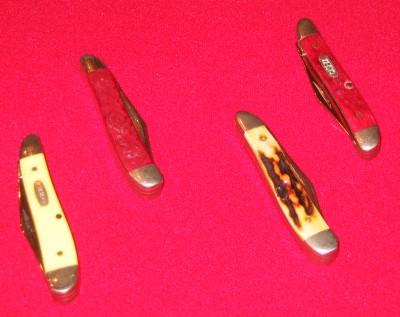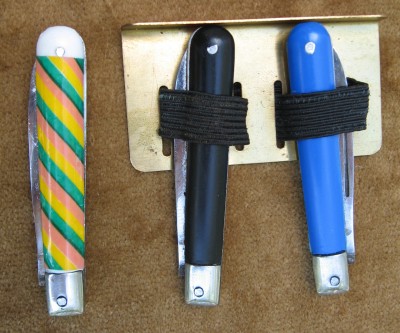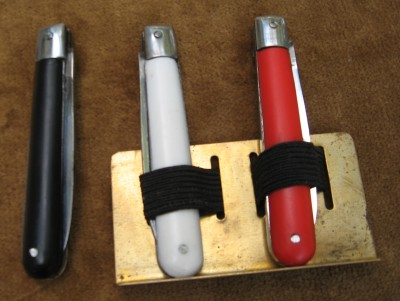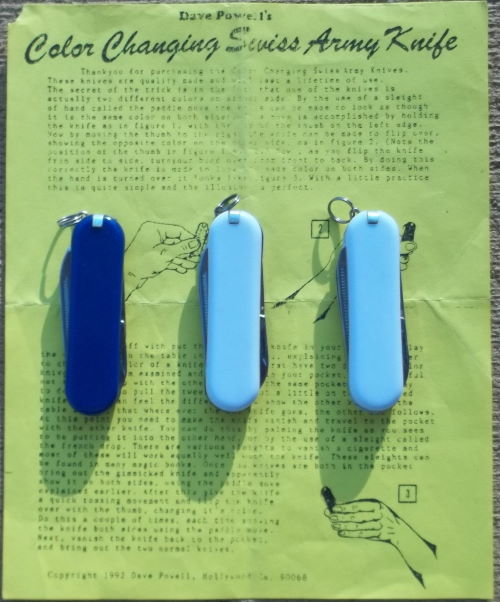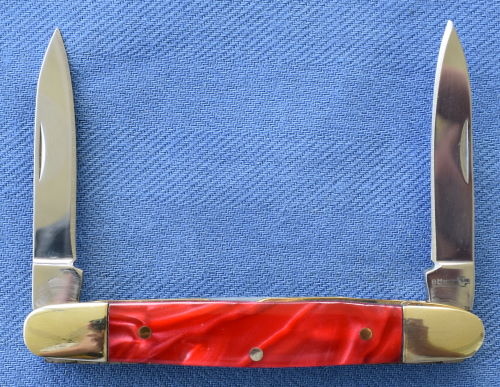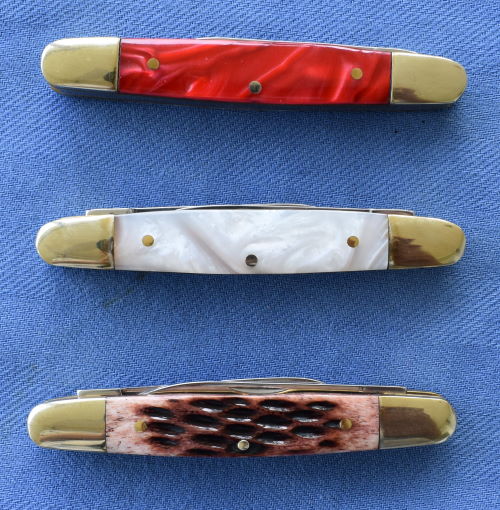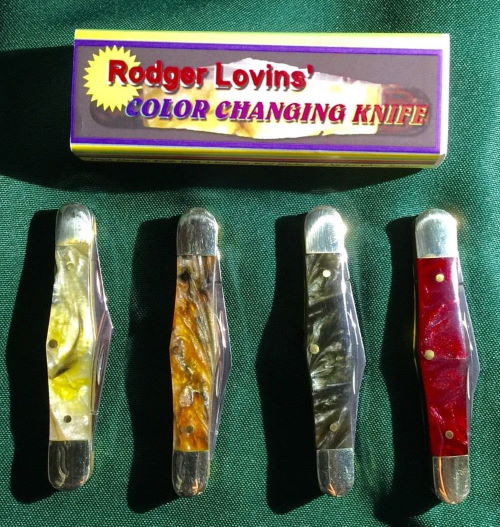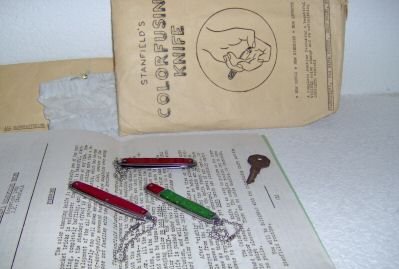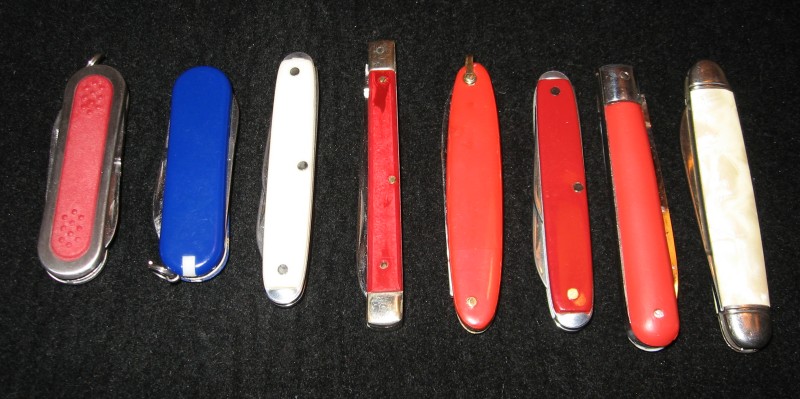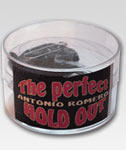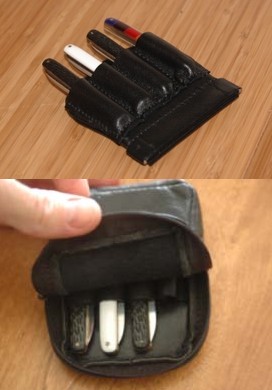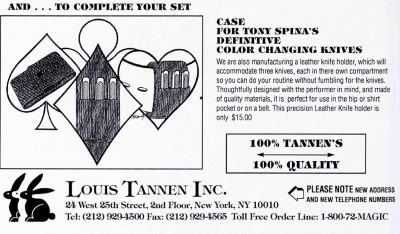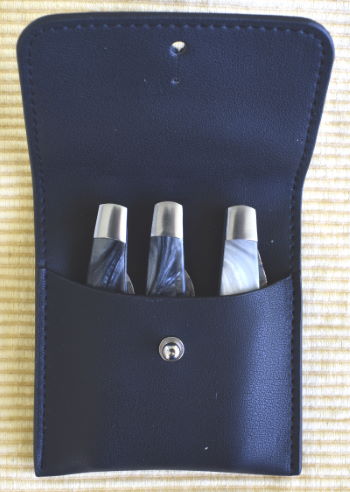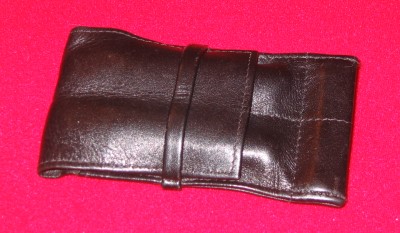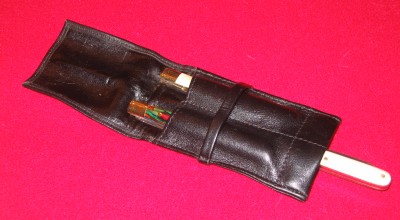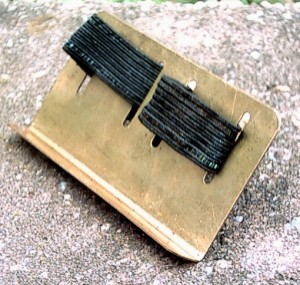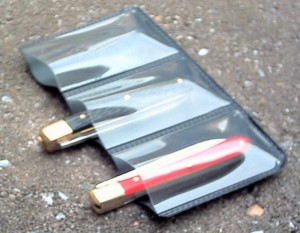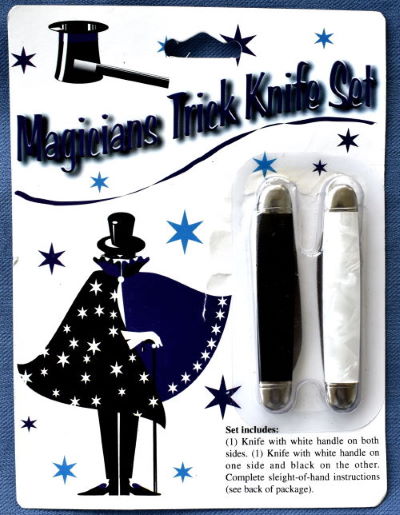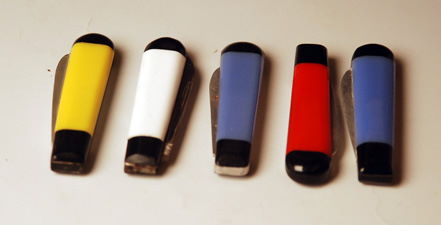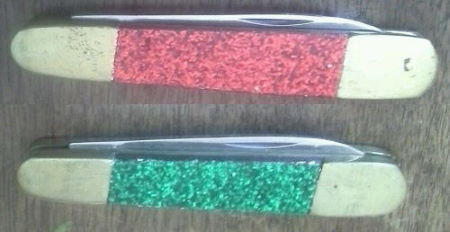Samples of Color Changing
Knives that have been on the market over the years.
Many of these are no longer available.
|
Knives are listed in Alphabetical order by Manufacturer
|
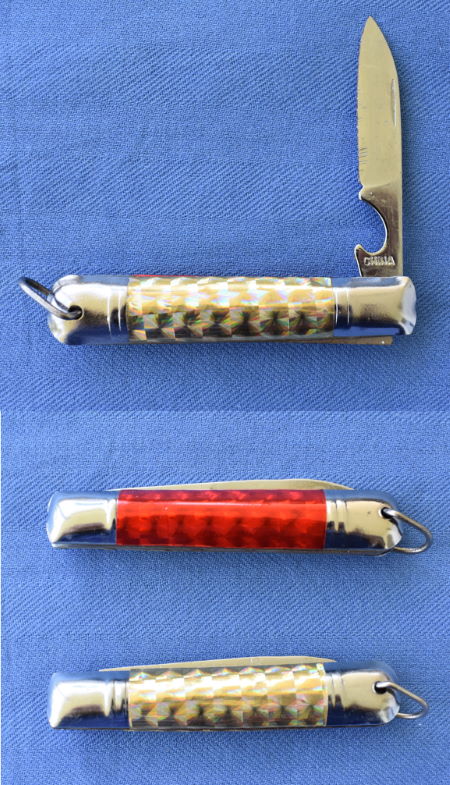
Image from Magicref
|
Don Arthur's Color Knife
These knives are tapered and appear to be the same knife
& pattern as the "Beyond Belief" knives below, including
the ring on the one end of the handle.
This was a two knife set with very basic and not very
helpful instructions. Consisted of a regular and a color
changing knife.
The rounded handle design made performing the necessary
sleights easy.
I believe Don Arthur ran a magic shop in Florida, and
perhaps is the same Don Arthur that wrote, "Illusions in the
Round".
Knives are 3 & 3/4" long (closed) and blade is marked
"China".
|

Image from advertisement in Stan Allen's Magic
magazine, April 2001
|
Bay Area Magic: Ultra
Color Changing Knives.
The Ultra-Color Changing knives were produced around 2001 by
Bay Area Magic. Somewhere I have notes that these knives
were by Michael Silver, but there is a review
in the Dec 2002 Genii for Bay Area Magic Ultra Color
Changing Knives by David Lowenstein, and the
description matches these.
They share a similar knife design as one of the Eric Wolf
knives (see further below), but without the rivet in the
handle. They featured fine wood handles in
walnut and maple with chrome finish bolsters on each
end.
The base knives were manufactured by Frost Cutlery. Each
knife measures 2 & 3/4 inches with rounded contours
and uniform shape, and they handle well. They were
available in a two knife set for about $100.
Reviewed in Genii, December 2002.
Bay Area Magic, San Francisco, CA
|
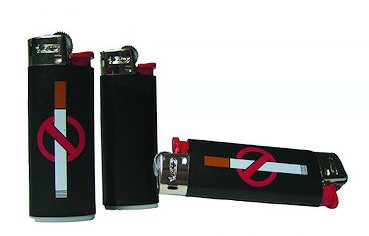
Image courtesy http://www.close-up-magic.com |
Bertrand, Jean-Luc: No Smoking
A CCK routine performed with specially made lighters. A
standard BIC lighter is designed for non-smokers, and the
image jumps on and off the lighter and from lighter to
lighter, ending with an "impossible object" climax. $60 |
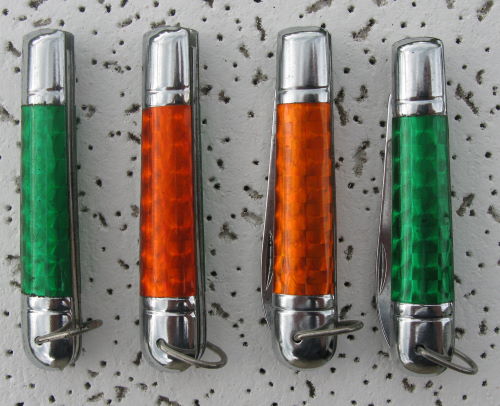
Beyond Belief Supreme Color Changing Knives
The Routine was supplied on a two-sided 8.5x11" sheet, with
no illustrations. Instructions are decent, describing The
Paddle Turn, Hand Flip, Color Change, and The Convincer,
which are then followed by the routine description. |
Beyond Belief's
Supreme Color Changing Knives
By Mark Mystique. These are tapered knives with wide ends,
and included paper-insert handle colors. Knives have a key
ring on one end, and one feature of the routine is a knife
vanish accomplished with an extra gimmick. The vanished
knife is later found in a closed box that has been in view.
The Deluxe set came with three knives. The Supreme Set adds
one extra knife and included a Velvet Box.
One of the unique features of this set is that two of the
knives intentionally have the blades further set into the
handle than the others. This aids the handling. One of the
other knives is the one that vanishes via the reel, and the
other knife is found inside the velvet box at the end.
Handling of these knives is acceptable, though they are much
too wide for my tastes.
Reviewed in Genii, July 1994. Retailed around $20-30
at the time.
The El Duco knives seem to be based off the same knife base,
but I think the key ring has been removed.
Beyond Belief, Lancaster, CA
|
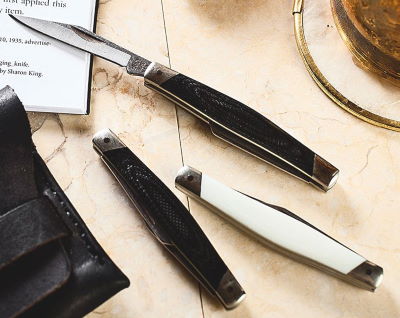
Image from DanAndDave.com
|
Buck, Dan & Dave:
A Practical Knife Routine for Gentleman.
With each set you’ll receive three
knives, a custom leather carrying case, and in a
beautifully bound and embossed pamphlet featuring expert
instruction from Jared Kopf.
Knives are Buck knives, about 2 & 5/8 inches long, and
have a very good fit and finish.
Dan and Dave LLC.
https://dananddave.com/
|

Photo courtesy Rhett Bryson
|
Jeff Busby: Color
Changing Knives
Rhett Bryson wrote me, "It is a set put out by Jeff
busby...It came in a white box with a custom "Bench Made
Magic" Busby sticker with the serial number on it. Inside is
a green felt bag with the three knives (B/R, R/R, B/B) and
has a sewn-in Busby label and a Made in USA label as well.
The knives are distinctively shaped and frankly a little
hard to do the paddle move with."
|
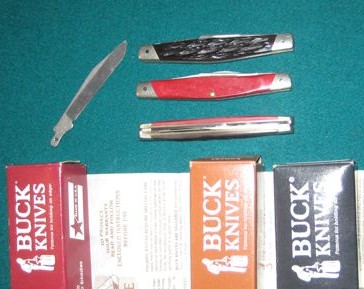
Brad Burt Color Changing Knives
Photo by Matt Herber
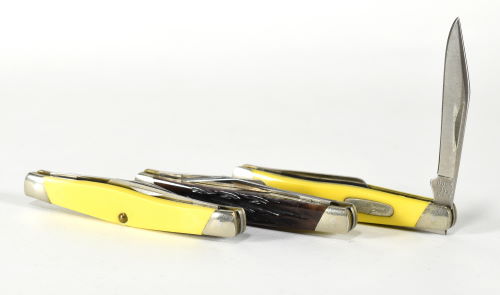
Image courtesy QuickerThanTheEye.com
|
Brad
Burt - Buck Color Changing Knives
These Buck Color Changing Knives pictured to the left were
bought by Matt Herbert from Brad Burt's Magic Shop in San
Diego, CA back in 1991. Two sets were offered, with either
two or three knives. Even then, the three knife set was $99.
Buck makes a good quality knife, resulting in a set of Color
Changing Knives that are top notch. They even came with an
additional blade. This was the Buck 305X model, from my
understanding. Size was 2.75", 6" extended.
Matt's recollection from a conversation with Brad is that
Brad had these knives actually produced for him by
Buck Knives; they were not knives that were purchased and
then modified.
Matt has a set of Scotty York knives, but prefers the Buck
Knives in his shows because they are real pocket knives.
Bottom photo is another set that was available up at the
QuickerThanTheEye website some time ago.
|
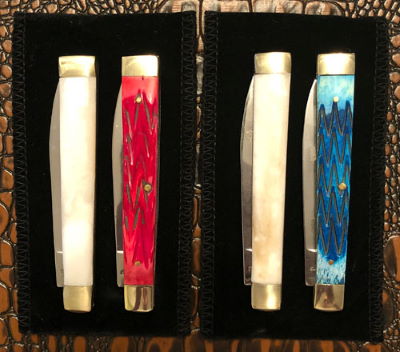
Stag Color Sets
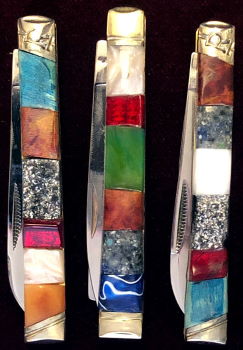
Hot Rod Knife
Images courtesy Meir Magic
|
Terry Broshears: Stag
Color Changing Knife Set.
Built from a 1893 "Doctor's Knife" style knife, 3.5" long,
about 1/4" thick. These are heavier knives than most. Come
in two knife sets, in a variety of different colors. Retail
$85.
TailLight Color Changing Knives set, using car
break-lights as the handle material and based on the same
knife base. Comes in two or three knife sets from $85 to
$125.
Sets include a velvet carry bag but no instructions.
Hot Rod Knife. Hand made single knife, each with a
unique set of colors and available in a variety of force
colors. No instructions. $45
Venue Approved Hot Rod Knife. A smaller, 2.75" knife
with 2" blade for legal use in a wider variety of states.
$37.50
These are currently available (2022) from Meir
Yedid Magic.
|
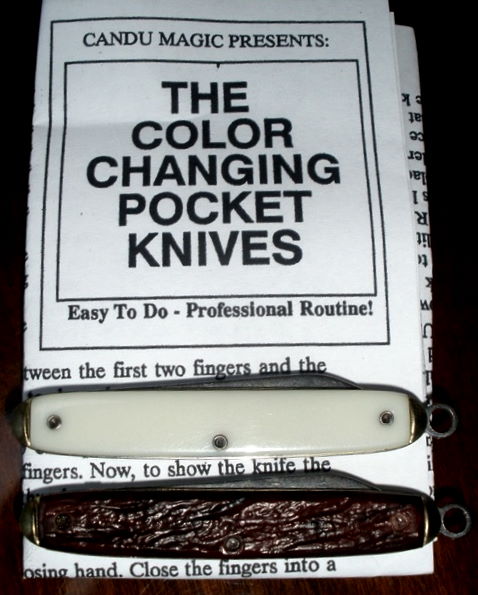
Image courtesy eBay seller jwells85018yi1
|
Candu Magic
The Color Changing Pocket Knives
Smaller knives with bolsters on both ends, and a keychain
eyelet on one end. As shown here with a brown stag handle,
and more commonly with a smooth black and white or black and
red handle set.
A nice set that handled well.
|
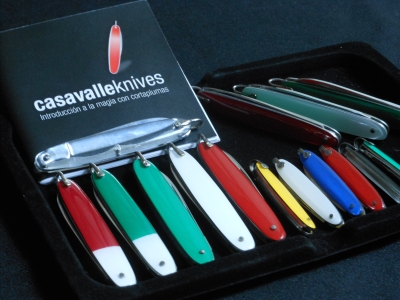
Image from Casavalle Kinves
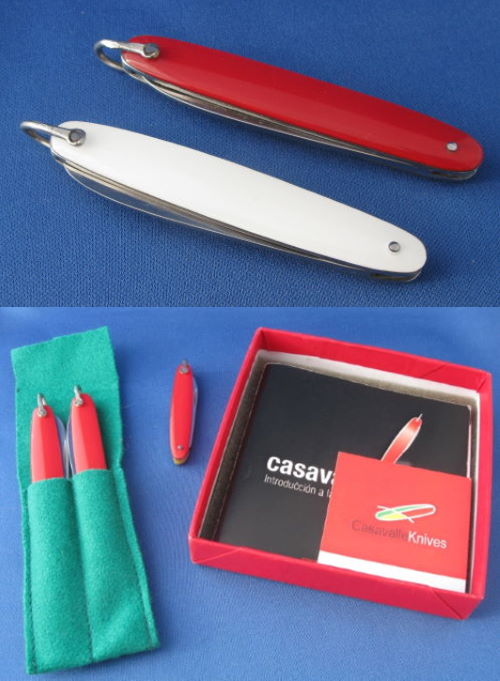
Image from Magicref
The Casavalle Knives come with a small instructional booklet
with several moves taught. Presently this book is only
available in Spanish.
|
Flavio Casavalle: Casavalle
Knives
The Casavalle knives are modeled after the Tamariz/Jose De
La Torre knives, but with modern materials and design
changes to minimize the potential for "flashing" and to
enhance handling.
The knives are very well made, with bright, highly
polished colors, and are available in a variety of colors,
to include the "visible-change" change knife, and smaller
knives for a climax finale.
They are currently available in Spain.
A slightly longer review of the Casavalle Knives is here.
CasavalleKnives.com
|
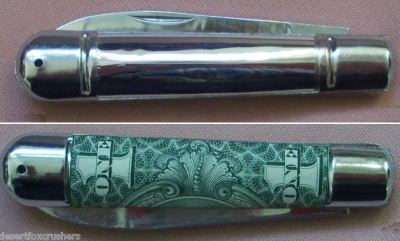
|
Chazpro: Reflecto-O-Knives
Color changing knives with a twist. These knives appear to
be the tapered design of the Beyond Belief knives (and a few
others as listed here). Chazpro took the idea of being able
to custom print a design on the handle, and provided three
different variations (or all available as a set):
Reflect-O-Money. The reflection of a dollar bill gets
captured in the knife. With the routine provided, the
reflection can be hit right out of the knife and unfolded,
revealing a real dollar bill (bill not included, of course).
Came with one knife. Originally $12.
Reflect-O-Matic. Similar to the above, but in this
version the blue color of an unusual blue card is captured.
Came with set of two knives. Originally $15.
Reflect-O-Cards. Included two effect - 1) capture the
image of the card box 2) capture the image of the selected
card. Came with set of two knives. Originally $15.
The set of all five knives was available for about $30.
Advertised in Stan Allen's Magic magazine, January
1998.
|
 |
Daryl's Color Changing
Knives
I don't believe these are available any longer, although the
routine is available on Daryl's DVD Fooler Doolers Volume 1.
These knives feature a bit of a wider and flat knife, which
may be more difficult to perform the moves with than a
narrower, more rounded knife.
However, the unique feature of this set is the "thumbprint"
on the two colored handle, making it appear as if the
color was painted on "live", and providing for a very unique
routine.
Reviewed in June 2001 The Linking Ring
Reviewied in July 2001 Genii
|

Image courtesy Potter
& Potter Auctions
|
Davenport's London. Demon
Color Changing Knives
A Two knife set with flat handles, no bolsters, and three
rivets. From the early 1950's. Note the Demon Head logo on
the end of the blade.
|
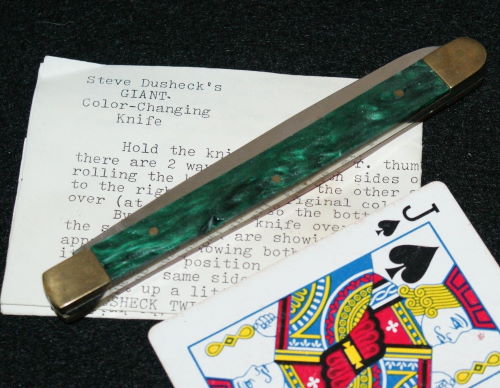
Image courtesy The Magic Gadget
Site
|
Steve Dusheck's
Giant Color-Changing Knife
A huge 5.5" knife designed after the Merrill Knife pattern.
Advertised in the July 1988 New Tops magazine. |

Image courtesy eBay seller Mulligan
Included a 9 page instruction manual
|
El Duco's Magic - El
Duco's Knife Routine
These used the tapered knife design as seen in the Beyond
Belief set and the Don Arthur set.
I don't notice the keyring in the photo, so this may be been
removed by El Duco's to enhance handling.
Another photo I've seen of this set showed Red & Blue,
so I expect there were various color combinations through
the years.
Christer Gustavsson's El Duco Magic of Sweden.
|
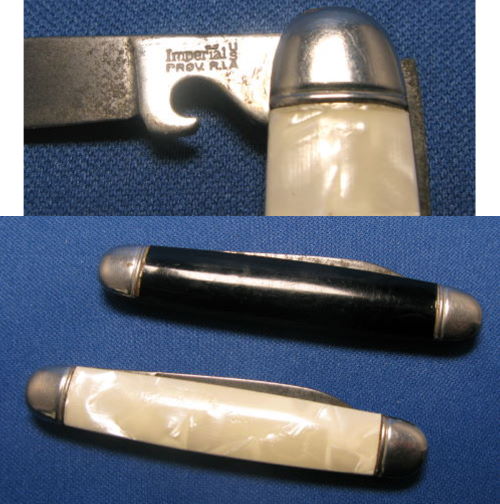
Image from Magicref
Routine: The
original Enardoe routine is one I consider a classic and is
very well done. I don't know if it comes with any of the
newer versions of this knife, however. The instructions came
on a two-sided 8.5"x5.5" sheet with illustrations and a very
logical routine that is not too hard for beginners.
|
Enardoe (E.O. Drane Co.):
The first color changing knife set I owned was from E.O.
Drane, otherwise known as the Enardoe knives (E.O. Drane
spelled backwards). This came standard as a two knife set:
one regular and one gimmicked in black and white. They used
to be available with either a regular all white knife or
regular all black knife. This would expand the routine
capabilities by obtaining two sets to provide a three knife
set (well, four counting the two gimmicked knives). In my
searches, however, the all-black knives don't seem to be
available anymore.
The Enardoe knives used to be made by Imperial Knife Co. in
the USA, and they are the "trick" knives in that only the
magician can open them.
The knives are fairly flat, and the covers have a slight
curve to them. They don't flash
when laid on a table due to the bolsters, but their flatness
and width make them slightly harder to handle, especially
for smaller hands. They represent a good, basic set.
While the original Enardoe knives are no longer available,
you can find replicas from several manufacturers for around
$20. I believe the current sets are made
by Morris, Empire (Loftus), and Royal Magic. The
trick knife feature is a nice bonus. I have also seen on the
Internet a Roy Rogers knife that appears to be similar. This
might add to your patter potential as a final switch.
|
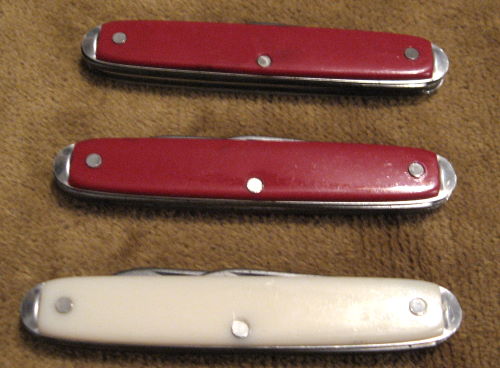
Fantastic Magic Co. Knives - older style, 2 blades
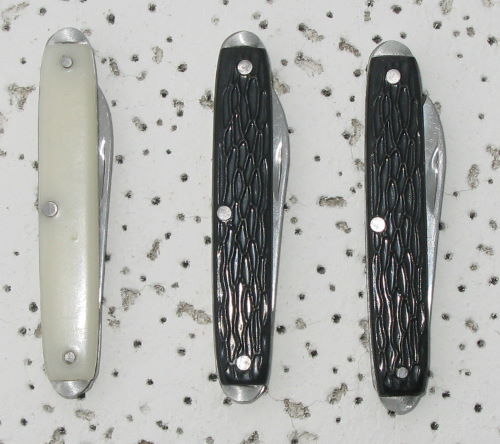
Fantastic Magic Co. Color Changing Knives, newer style
|
Fantastic Magic Company, Inc.
The Fantastic Magic Co., was originally owned by R.D.
Merrill, and Gary Frank carried on the Merrill Color
Changing Knives after purchasing the company in 1975. After
production of the Merrill knives was ceased, Gary began to
produce the knives seen in the top photo.
These were double bladed knives with a very nice finish and
feel, with a good weight to them. The extra thickness from
the two blades enhanced the handling. The base knives were
made by the Colonial Knife Company in the USA.
After these knives were no longer available, Gary Frank had
to switch to the knives in the bottom picture.
These knives have several advantages: 1) they
aren't too wide; 2) they have bolsters at both ends,
which makes them very symmetrical and eliminates any "show"
when spectators view the knives from the ends; 3) the
stag/smooth handle differences make finding the correct
knife in your pocket easier; and 4) they look like
regular pocket knives.
The knives are 2 & 7/8" long and a three knife set comes
with Dr. Merrill's Classic Color Changing Knives and Paddle
Routines booklet (a subset of the Merrill Knife book). Gary
also offers a Visible Color change knife (also in B&W)
for $20. In overall handling, I still prefer the Mogar
knives, but Gary's knives represent a suitable alternative.
These (bottom) knives were also available from Mark Wilson,
along with a short 18 minute DVD of Mark's straightforward
color changing knife routine.
|
|
Michael Frahme's
Custom Color Changing Knives.
Michael made these knives just for himself and was kind
enough to donate a few photos for this web site. They are
not available for sale, but they do show what a nice set of
custom knives can come out like. Michael wrote that the guys
at Tannen's in NY wanted a set, but he had to tell them he
didn't want to go into business. Michael used CASE peanut
knives as the base.
Michael also sent me photos of the Weber knife case (see
below) |
Routine: The routine
that comes with the "Ganson" set (top photo) is very
good, and is simply a reprint of the routine as found in
Ganson's Routined
Manipulation (see the Books section for a full
table of contents listing). The other set is titled Three Color Changing Pen Knife,
and is provided on two single sided illustrated A4 sized
sheets. It includes two basic routines, and describes The
Paddle Move, The Flick, and The Switch.
|
Funtime
Magic / "Ganson" Knives:
Around the year 2000, some inexpensive sets
were made in India known as the Ganson knives, since
with one of the sets a routine by Lewis Ganson (from his
book, Routined
Manipulation) is included. There were five knife
colors available: black, white, red, blue, and white with
colored stripes. The black, white, red and blue handles are
plastic, with one rivet and probably glued the rest of the
way. The striping on the white knife is achieved through a
clear striped sticky paper. I didn't peel it off, but this
idea could be used to make a regular knife into a color
changing knife if you can find some clear tape with colored
stripes on it, or for that matter, colored tape. The colors
are "dull", rather than shiny. There is one bolster, and the
liners and bolster are silver. The handles are rounded at
the edges, which aids in the handling. Even though they are
rounded, they don't flash
easily as long as your angles are right, but you need to use
more caution than with the flatter Enardoe knives. Also,
because the color goes all the way to one end, you have to
be sure to keep this end away from the audience because the
non-bolster end does
flash.
The knives are cheaply made with no country of origin
stamped on the blades. They are difficult to open, and some
don't close cleanly (each knife varies). The fit and finish
is not so good, and there are significant gaps between the
bolsters and the handles.
The sets also come with a brass bent metal knife holder, so
you can keep the knives straight while in your pocket.
However, the holders don't work so well because they use a
single piece of elastic. When one knife is removed, the
other knife now hangs too loosely in the holder. This can be
easily remedied, however, by simply replacing the elastic
with individual pieces.
I purchased two sets in order to obtain all the colors.
Despite the low cost and cheap quality, these knives are
decent to work with. They "work well", in my hands anyway,
and they are inexpensive enough that if you lose one you
won't be too upset! I could recommend these knives as a good
first set. Their main advantage over the Enardoe knives is
the variety of colors available, but I certainly give the
Enardoe-style knives the edge in quality
|
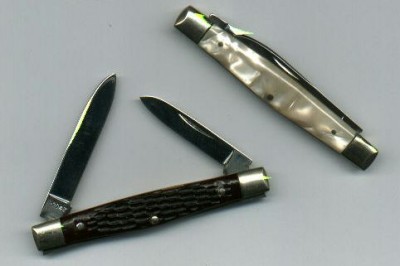
J.P. Jackson Color Changing Knives
Photo by Mike Rogers
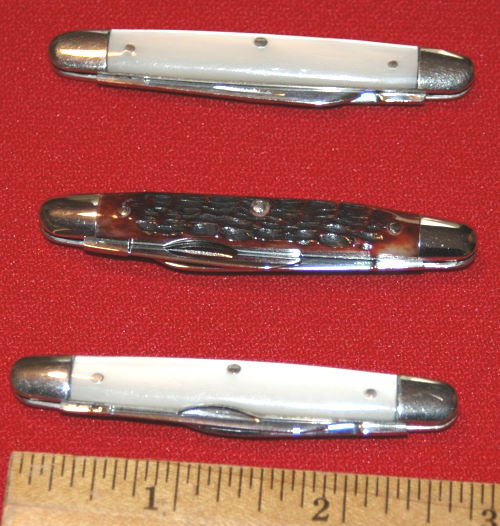
|
J.P. Jackson
Custom Knives:
There are probably many custom sets out there in magicland.
J.P Jackson used to be found working at Brad Burt's
Magic Shop in San Diego until Brad closed up his brick
& mortar shop. Sadly, J.P. Jackson passed away in 2013.
J.P. made sets using CASE brand knives, which are
excellent. The main problem has been in getting a supply of
knives to work from however. CASE stopped making both the
designs that J.P. used as his base. Thus, J.P. could only
make sets as older knives are made available to him, which
certainly drove up the price!
The top photo is of one of J.P.'s original sets. I had
never seen a set of these knives until this photo was sent
to me from Mike Rogers, who was kind enough to let me post
it here. By the looks of the photo, they appear to be
an excellent set. When Mike sent me the top photo,
he stated that these knives were great, but that he
still preferred his Sanders' knives.
In an interesting bit of trivia, J.P. re-acquired this set
after Mike's passing, so they were of extra value to him!
In the early 2000's, J.P. was able to find another CASE
design that made for a nice color changing knife set. The
bottom photo at left from 2006. As with the above
set, CASE no longer makes this knife either, so
availability was an issue.
J.P. was still making knives back in 2006 on a case-by-case
basis. I have no idea how many sets he may have made and
sold.
Costs for custom knife sets will vary depending on the
knives used and availability, but certainly plan on spending
over $200 for a three knife set. |
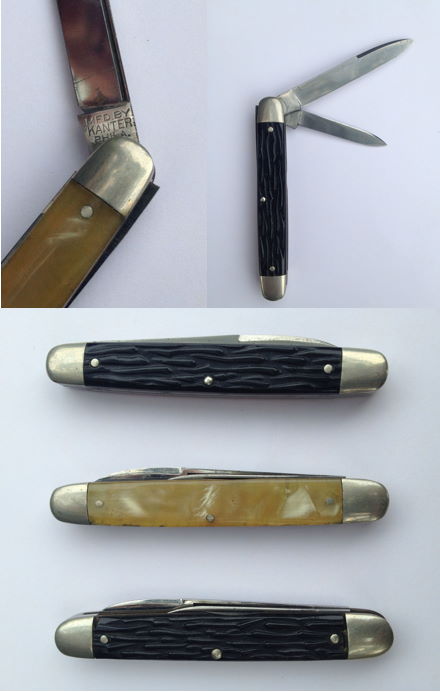
Photos courtesy Brad Jeffers
|
Kanter's
Chameleon Knives:
The Kanter knives are one of the earliest color changing
knives. on the market. They were advertised as early as 1936
in The Linking Ring magazine (International Brotherhood of
Magicians) where they state, "most popular trick of
1935". And the last page of the December 1935 "The
Magic Wand" advertises Kanter's Chameleon Colour Changing
Pocket Knife."
Though I haven't seen any personally, these appear to be a
well made, two bladed knives. The bolsters at both ends
would prevent flashing, and the thickness appears to aid the
necessary sleights.
These photos sent to be by Brad Jeffers is a great
representation.
One of the ad prints states, " "This is the pocket trick we
brought out recently using a high-grade pocketknife which
changes colors right before the spectator's eyes. It must be
a good trick as we have sold several thousand of the
original Kanter knives and, in addition, it is probably the
most IMITATED trick on the market. Please note, we said
IMITATED - we don't mean DUPLICATED ... for nobody has ever
duplicated the Kanter knife"
Kanter's Magic Shop, Philadelphia, PA.
|

Image courtesy Folini & Sons Magic

Image courtesy eBay seller *go-n-go-n-gone*
Visible change knife, part of a red & white three
knife set
The routine that was shown with the above set was just a
single page of basic moves that "can be employed in
conjunction with others of your own to provide a
professional quality routine."
|
Keen's Professional
Color Changing Knives
These knives are just about 3" long, with brass bolsters at
both ends. This is a single blade knife.
I've seen two knife sets in white and blue, and a three
knife set in red & white, which also included a split
visible change knife.
The photos for the red & white set showed the main blade
stamped with "Mexico".
Keen's Magic Gift Shop, Inc, Waco, TX
|
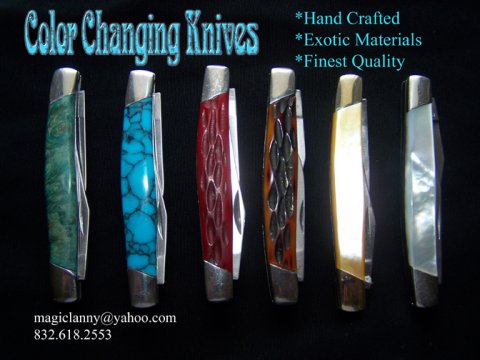 |
Lee Kibbey Custom
Knives
MagicLanny makes a knife set based on a Winchester knife.
The reviews on Richard Mendez' The Magic Museum site rates
them very well.
They can be purchased directly, and sets are occasionally
found available on e-Bay.
I have heard good things about these knives from others as
well, and they are available in a variety of materials, as
seen in the photo. |
Photo to come!
|
Long, Chad: Flash!
A variation of the color changing knives using USB-style
Flash Drives instead of knives. Includes 2 small flash
drives, 1 long flash drive, and full color instructions (the
drives are custom made and are not working memory sticks).
|
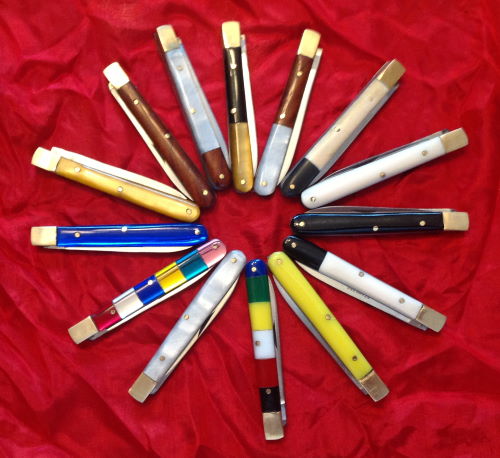
MagicToad made knives in a wide variety of colors!
|
Magic Toad Knives
(Metodie Jorgancievski - the Magic Toad).
Custom knives similar in style to Mogar knives, and in a
wide variety of colors. I purchased a set and really like
the handle material, and since the knife style is similar to
Mogar's, the handling is excellent. |

Merrill Knives - Japan
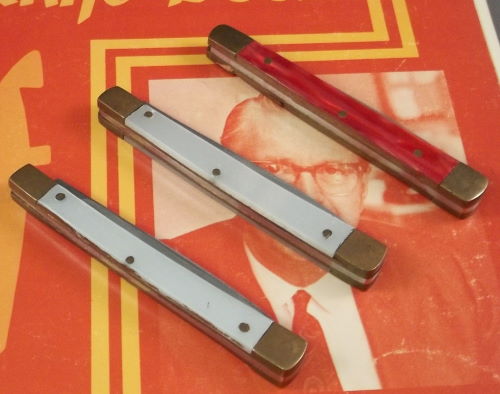
Merrill Knives - Pakistan
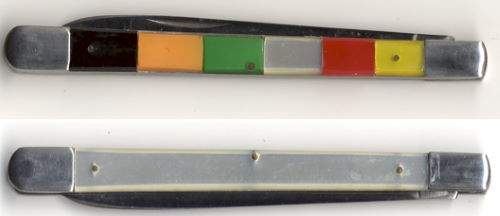
There was even a Hot Rod knife
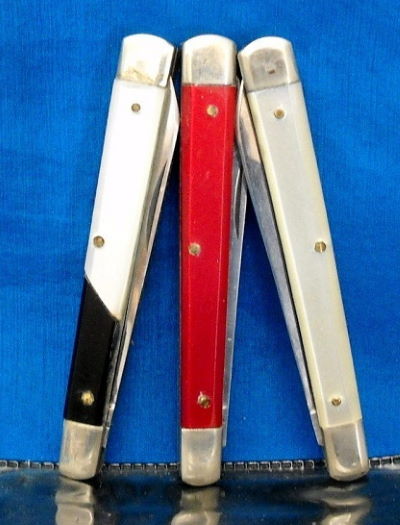
Note the diagonal join on the visible change knife
(Photo courtesy Craig Brooks of AtlantisMagic)
Routines:
Merrill's Knife Book would have likely been purchased along
with these knives. It is fully described in the Books section and is
an excellent resource no matter what set of knives you own.
Gary Frank sells the
Merrill Knife Book, along with a more inexpensive "extract"
in booklet format.
|
Merrill Knives:
by Dr. R.D. Merrill. These knives are nice, but sadly no
longer commercially available (production of the silver
bolstered knives ceased in 1977). My first introduction to
these knives was the purchased of a used set in red and
white, with a third visible change knife. After purchasing,
I was informed that the set I obtained were not "original"
Merrill knives, but later generation copies. These later
generation Merrill-type knives have brass bolsters
and were made in Pakistan. The originals have silver
bolsters and were made in Japan.
I have since obtained a set of "original" Merrill's as well,
shown here in the top photo. The colors are pearlized, and
look very normal for a knife. The knife is fairly flat, but
narrower and more square than the Enardoe knives, so they
handle very easily. The flatness (along with bolsters at
both ends) also helps them not to flash, and they can be
laid on the table without fear. The blades open and close
well with a good snap. Three rivets hold each cover on.
Original Merrill's came in Red/White or Black/White, and in
the later years, more colors were made available.
For me, these knives are about perfect. If you can find a
set, I highly recommend them. Even the inferior
Pakistani-made sets are pretty good (since they've copied
the basic Merrill design), though the fit and finish leave
much to be desired.
The middle photo is a set of knives manufactured in
Pakistan. The fit and finish of the Pakistan made knives was
not at the same level of excellence as the original
Merrill's.
The next photo shows the Merrill "Million to One" knife,
issued in a Jumbo size, to be used as a "Hot Rod" style
knife. This knife was available in the late 60's, early
70's, and is likely quite a collectors item (this photo
courtesy Gary Frank). As seen below, Ray Szwec re-introduced
this concept, which is now available from Joe Mogar.
Finally, Craig Brooks of Atlantis Magic wrote that Gary
Frank informed him that the earliest Merrill knives feature
a diagonal join on the two-color handle (as shown in bottom
photo on the left) rather than the horizontal join as found
on the later knives (compare to top photo). Apparently there
were complaints that the join was challenging to conceal, so
the design was changed to a horizontal join instead.
(Earlier I had assumed the diagonal was harder to
manufacturer to close tolerances).
An article on R.D. Merrill and his knives can be read here.
|
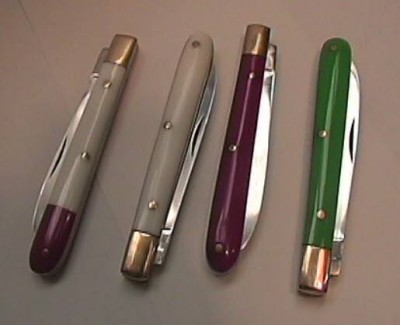
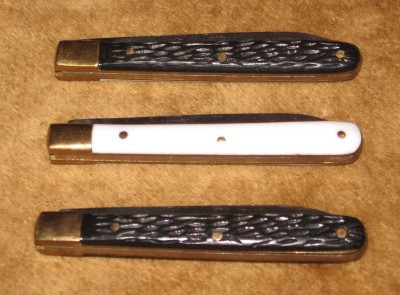
Photos by Magicref
Routines: The
routines supplied with Joe's knives are very good, and the
routine you get depends on the set purchased. All sets come
with a separate set of illustrated instructions that explain
the moves, including The Master Twist, Push Through, Push
Thru Change, Push In Vanish, and Twirl Change. The routines
that I have seen are Mogars's
Fantasy Knives and Mogar's Miracle Knife Routine; both of
which are well done and clearly explained
|
Joe
Mogar Color Changing Knives:
Joe Mogar knives have become (in my opinion) the
"industry standard", and for good reason. They are
reasonably priced, good quality, well designed, and come in
a wide variety of colors. In addition, jumbo and miniature
knives are available to add to the variety of magic
possibilities.
There is no country of origin stamped on the blades, and the
fit and finish is good. In addition, the Mogar knives fit
the bill as a workable pocket knife. They open well, and
have a good snap. The colors are solid, and I can say the
knife looks like a pocket knife should.
There are a ton of color and material combinations
available, the photos here show only a few.
The single bolster and liners are made of brass, and the
covers are put in place by three rivets that look the same
on both sides. As stated, a wide variety of colors are
available: red, white, black, yellow, and green just some
examples. A visible color change knife is available, as are
some specialty knives such as an American Flag knife.
Joe also makes the Whit Haydn knives, which feature black
stag handles (see bottom photo). The black stag-type handle
allows you to easily determine which side is which when
reaching for a knife in your pocket. There is no
shield.
The covers are rounded, and this is my only mis-giving with
the Mogar knives. If you aren't careful with your angles,
the knives could flash,
though this shouldn't be a problem for most routines. If
this does bother you, Joe also makes a line of "Perfect
Knives" that have silk-screened colors under clear covers,
with no possibility of flashing!
Knives are about $30 each for the regular knives, and more
for specialty knives. Joe sells complete sets with good
routines and vinyl carrying cases.
All the knives handle very well, and I highly recommend
them. Overall, I rate them higher than the Ganson and
Enardoe products, and on par with the Merrill knives.
Advertised in Genii starting around Dec 1999
The full line of colors and variations can be found on Joe's
website:
Joe
Mogar / Magic Stars Studio, NJ
|
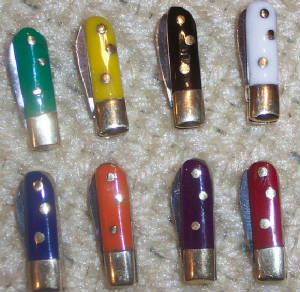 |
Mogar Tiny
Knives: Joe Mogar also makes some other
interesting knives, including a Rainbow Knife, a Hot Rod
knife (by Ray Szwec, see below), large jumbo knives, a flag
knife, bone handled knives, and others. The photo at
right are the tiny knives. See Joe's website for the latest
prices and availability. |
Routine: I was also
disappointed because I was hoping that at least my purchase
might include a good routine, but alas, Dave's instructions
were pretty meager. The instruction sheet is ©1992, and is a
single-sided yellow sheet about 7"x6" sheet with three
illustrations.
Routine: Two knives are shown and examined. Blue knife is
put in pocket. The remaining knife is vanished (using your
favorite method) and returns with the other knife. A white
knife is removed from the pocket, and changes to Blue. It
changes color a few times, until it vanishes and both knives
are now removed again for examination.
|
Dave Powell's Color Changing Swiss
Army Knife.
I purchased these knives in Aug 2006, and as far as I
know they were the last set left at Midwest Magic. I had put
off buying a Swiss Army knife because these knives are a bit
too wide and shallow and make handling a bit more difficult.
However, since I carry a similar knife on my keychain all
the time, I figured I should at least have a set in my
collection, and they weren't too expensive (which is
important for my budget!)
Although my suspicions held out, overall I was pleasantly
surprised. Handling is similar to the Enardoe knives. That
is, in my smaller hands at least, the moves are quite
doable, but don't come quite as easy as with the Mogar
knives, and I have to make sure my hands are a bit "tacky"
and not too dry. The knives are very short, however, so they
feel very comfortable in the hands. The stark contrast
between the blue and the white makes up for their small size
in visibility.
One other negative, besides the wideness, is the lack of
bolsters makes these knives subject to flashing, so you have
to be careful with the handling. I would use these knives in
a more casual setting, perhaps taking the knife off your
keychain to show a quick trick, since close scrutiny could
betray the secret.
Although I don't think Dave Powell's version is available
any more, I have seen occasional references to Color
Changing Swiss Army Knives during Google searches.
Advertised in the Summer 1992 Club 71 magazine from
Repro Magic
|
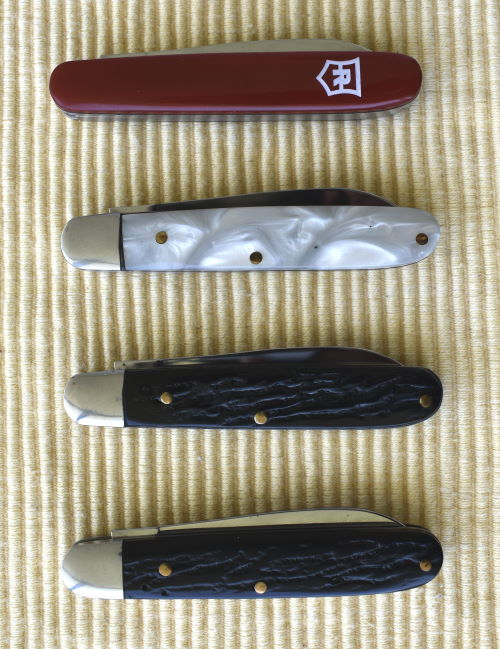
Image from Magicref
|
David Regal's Color Changing Knives
A Custom-Made Four Knife Set. Designed from the ground up.
Textured handles to allow identification by touch. Includes
a Swiss Army Knife climax.
Knives consist of:
a. Black Stag knife
b. Stag/Pearl
c. Pearl knife
d. Stag/Swiss Army
Purchase includes online video instructions.
Knives measure 3" in length (closed) and have a single
blade.They have a good weight to them and feel sturdy. Knife
handles are not marked with country of origin. Fit and
finish is good. In the set I purchased there is a slight gap
between one white handle and the bolster, but the gap is
filled in with what I guess in an epoxy The other knives
have no gaps.
List Price $125.
David Regal; https://davidregal.com
|
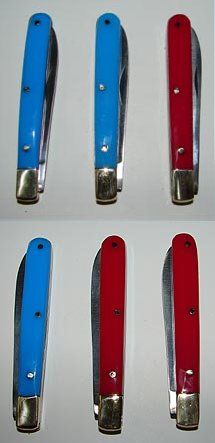
Photo courtesy James Riser |
James
Riser's Color Changing Knives
James Riser has started making small runs of color changing
knives. They are currently available two or three knife sets
in Red/LightBlue, Red/Yellow, Purple/Yellow, Navy Blue/Red,
Purple/Red, Light Blue/Yellow, or Red/Green.
They look to me much like the same knife base as Joe Mogar's
knives, but I don't own a set to make a side-by-side
comparison.
James' work is always of top quality, and at $60 a set (as
of Nov 2009), they are quite affordable.
I don't believe they come with a routine.
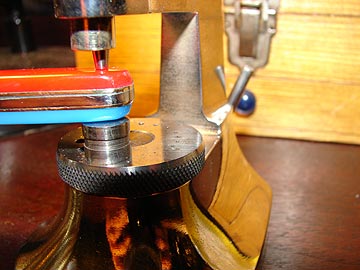
Riveting the Handle
|
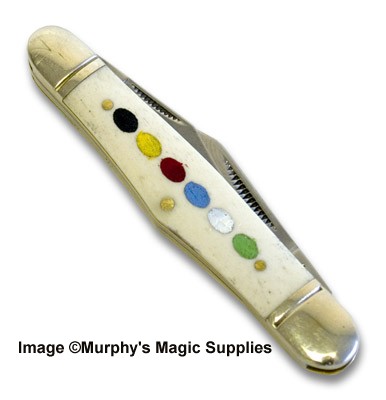
Rodger Lovins' Hot Knife
|
Rodger
Lovins' Color Changing Knives
Rodger Lovins' has released at least four separate color
changing knife products.
Rodger Lovins' Hot Knife
An updated version of the "Hot Rod" effect in color changing
knife form.
Appears to be a three-bladed knife, with bone handles and
nickel silver bolsters. While the Merrill version and the
Ray Szwec/Joe Mogar version use multiple handle pieces to
make up the rainbow, this knife appears to have the colors
just painted on.
Reviewed in the April 2007 Genii.
Reviewed in the August 2007 The Linking Ring.
Reviewed in the April 2007 Magic magazine.
Transformed Knives.
The Transformed Knife collection features a three bladed
knife, with stainless steel blades, brass liners, and silver
bolsters. The knives feature a Pearl White and Brown Jigged
Bone handles for good contrast. Size is 3.5" long by 0.5"
wide. The single gimmicked knife is available alone as the Ultimate
Color Changing Knife as well.
Transformed Knives were advertised around 2012.
Magnum Color Changing Knife Set (I think also called
"Our Very Best" set).
Made from Boker, two bladed knives. The basic change is a
Stag to Perl, but also to a start Red for the final climax,
though no routine is provided.
Knives are 3 & 1/16" long, and fairly deep at 1/2" at
the center.
These knives are hefty. Quality of construction is very
good.
Lists for about $150 for a three knife set.
Rodger Lovins' Color Changing Knife.
This set is designed off a base from Chimney Rock Knives, I
believe. This is a three-bladed knife.
Colors available were Sunset Yellow with Antique Red, Black
Pearl, or Burnt Amber.
From the description at Penguin Magic: "This Sunset Yellow
with Burnt Amber color changing knife is built to last! It
is a custom made, high quality knife with 3 high polished
stainless steel blades, solid brass liners and pins and
nickel silver bolsters. This knife has deep etched thumb
pulls located on both sides of every blade for an extra
added subtlety. The slightly rounded shape makes the "paddle
move" easy to perform and very deceptive. The size is 3 ½
inches long, ½ inch wide and ¾ inches tall. This is not a
cheap dollar store knife. The machine work is precise in
every detail. The handles are absolutely beautiful. A
matching Sunset Yellow ungimmicked knife is also available
in a limited supply."
|
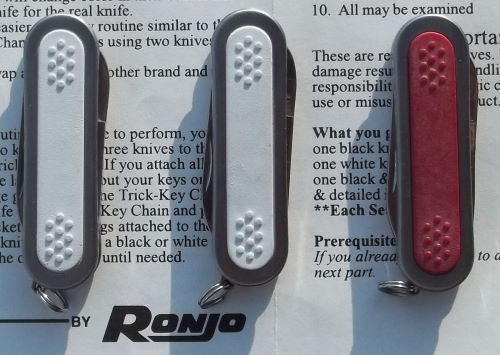
Ronjo Color Changing Knives
|
Ronjo
Transposing Color
Changing Knives.
These knives were inexpensive at $15 for a set of three, and
are about the same size as the Swiss Army knives above.
Because the color is inlaid in the handle instead of going
all the way to the edges, these knives will never flash. However, they
are also a bit too wide to make the handling easy. Thus,
even though they are designed for the beginner, they are not
all that easy for the beginner to use. Instructions are
sparse, taking up 4 panels of a 4.25"x11" sheet, with no
illustrations. Made in China.
Routine Outline: Red Knife & White Knife in fist. Red
knife removed and changes to White; Red knife revealed in
fist. Red knife to pocket & White one in fist; White
turns to Red and White knife is removed from pocket.
Red knife left in fist and White returned to pocket.
Fist is opened to reveal White knife, Red is removed from
pocket, and all can be examined.
Also supports the Ronjo Trick-Key Chain system. This is a
series of tricks that you can carry with you on a specially
designed key-chain. See Ronjo's
website for details.
|
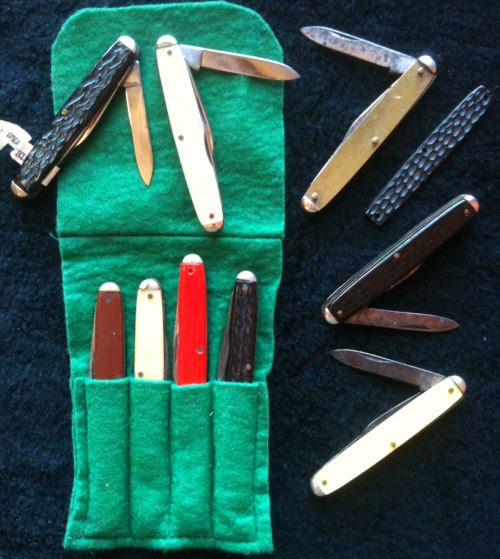
Image courtesy Steve Goldstein
Steve stated that his favorite knife was the one with no
handles, which made for a great climax.
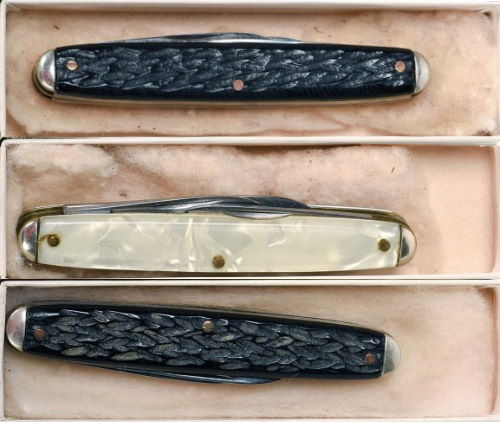
J.P. Jackson's set of Sanders Knives
Photo courtesy PotterAuctions
|
Sanders' Knives:
The Jimmy Sanders' knives seem to be considered by those who
own them to be the best ever available.
Since I have never seen a set in person, it is difficult for
me to comment. Mike Rogers had sent me a photo of his
personal set that was almost 50 years old, and stated that
these knives "were made for the trick and they are perfect."
The large blade is stamped "SAMCO TENN" for Sanders'
Manufacturing Company, Tennessee. The original set came with
three knives, one with a removable bone handle so you could
even have the handle disappear! In his book, "The Complete
Mike Rogers", Mike states that the routine included with the
knives "tended to be lengthy, but good".
Obvious features from the photo include: 1) Bolsters on both
ends; 2) looks like a real knife, with multiple blades; 3)
Even though the knives appear flat in the photo, the
multiple blades will necessarily thicken the knife,
enhancing the ability to perform the knife moves.
Length 2 7/8", width 5/16". Three blade knives.
Standard colors were S-294 Pearl Finish, S-294A Stag, S-294B
Stag/Pearl handles. Other colors were also available: black,
red, green, yellow, and a small knife. In one routine the
handle appears to come off.
Sanders' knives go for considerable money when you can find
them.
The set to the left belongs to Steve Goldstein. You can see
that the knives were available in quite a variety of colors
and materials
Advertised as early as the October 1939 issue of Genii
Magazine.
|
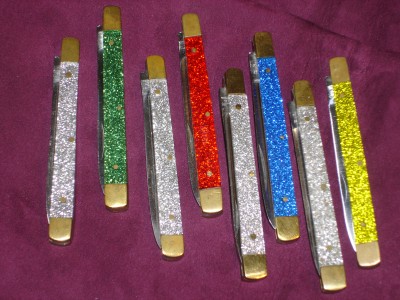 |
Sparkle
Knives:
These knives look like Merrill Pakistani knives, but with
very glitzy handles.
(photo courtesy Ray Szwec) |
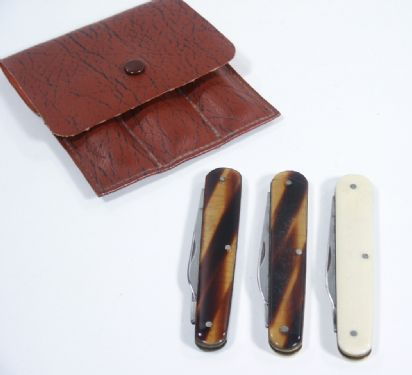
Image courtesy KTMagic Auction
|
Harry Stanley Color
Changing Knives
Included 6 page illustrated Ken Brooke routine The knifes
are of Stainless Steel blades and by Sheffield of England.
Came with one white knife, one tortoise color knife and one
white/tortoise. Included a carrying case.
|
|
Image from an unknown e-Bay seller
Included a 10 page manuscript.
|
Stanfield's
Colorfusing Knife:
Another set from the past, John C. Stanfield's Colorfusing
Knife. Note that the knives include a ring at the end to
hold a keychain. At the beginning of the routine, the knife
would be removed from the keychain. The color changes would
occur. At the end the knife is tossed into the hand holding
the keychain with keys, and immediately the hand is opened
to reveal the knife is back on the chain.
Most of the articles I've seen credit John Stanfield with
the split color, "visible" color change knife. With this
knife, one portion of the handle is seen to be red and the
other portion green as the knife passes through the
fingers. Thus, the spectator sees the color change
actually taking place!
The Stanfield knives are approximately 3 inches long
(closed).
Advertised in Hugard's Magic Monthly, June 1952.
Advertised in The Sphinx, December 1952.
Reviewed in The Linking Ring, August 1952.
Stanfields, East Point, Georgia.
|
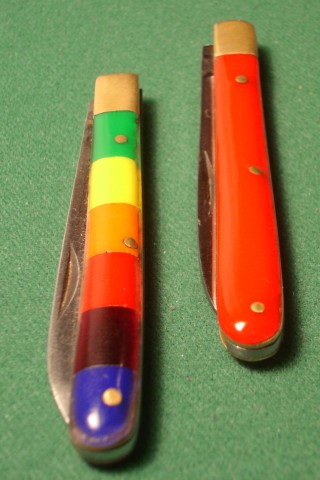
|
Ray Szwec Hot Rod Knife:
Ray Szwec had Joe Mogar produce a rainbow knife that can be
used for the popular Hot Rod effect. This knife could make
an excellent addition to any Color Changing Knife routine.
After the knife explodes into a 6 color rainbow knife, you
ask the spectator to pick a number from one to six. The
knife then changes to the corresponding color for a
triumphant climax. As seen in the Jan 2003 issue of
Genii and the June 2002 issue of The Linking Ring.
(see also Ray's custom knives, further below) |


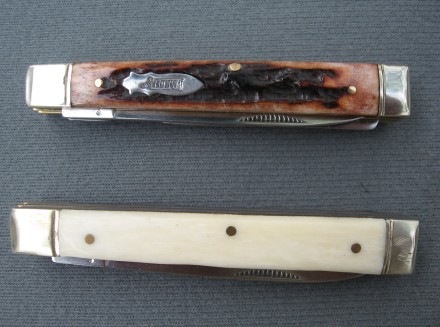
|
Ray
Szwec Custom
Color Changing Knives
Some years ago Ray came up with the
idea of making a Hot Rod Color Changing Knife (without
knowing about the earlier Merrill version). Joe Mogar is
currently making this knife along with Joe's other excellent
knives (see above).
Recently, Ray has begun experimenting on a small scale with
some of his own knives and has been offering them on e-Bay.
Pictured to the left is a set that was sold on e-Bay. A set
that I purchased are shown below (the three larger knives to
the left).
The knives are of Chinese origin, but are well made. The
size is over 3", so they are a bit unusual to handle, but
the weight is great! I can't do some of the normal color
changing knife moves (such as some vanishes) since these
knives stick out of my hands, but they are certainly
suitable for many routines.
The only other downside of this current crop is the
inclusion of the Crest on the handle. In my view, the color
change should be a simple as possible, and the inclusion of
the emblem just complicates it a bit. Ray tells me he is
planning on making some other versions soon that don't
include the Crest. On the other hand, such an emblem is a
part of many ordinary knives, so it certainly isn't totally
out of place.
Ray also started making a set of smaller knives based on a
Marbles' Cutlery Small Doctors pocket knife. A comparison
with Ray's larger knives is shown to the right, and a closer
look at the new model is below. Ray only makes a two-knife
version in this smaller size because of the need to custom
make one handle.
While many Marbles' knives are made in the USA (and are
quite pricey), the newest owner has begun a set of
"international" knives that are made in China and are less
expensive. The quality of these knives appears to be pretty
good, with nice fit & finish and a good "snap" to the
spring.
The Marbles' knife is 3 1/4" and features two blades: a
spear blade and a special "spatula" blade. My only compliant
with this knife as a base is that it is a bit too square. The
knife almost turns over on its own in your hand if you are
not careful. I did find a good use for this, however, as
this "rolling" makes easy a quick color change by simply
waving one hand over the other. If this knife were single
bladed, I think it would have been perfect!
Ray's craftsmanship is good. The bone handle is smooth and
meets the bolsters well. He has taken the extra step to
duplicate the rivets as seen on the bone handle side, which
is a lot of extra work.
You can look for Ray's knives on e-Bay (seller buckthornroad) or
contact him personally at: szwec <at> optonline.net
(replace the <at> with the normal @ symbol; done this
way to help Ray avoid automatic spammers!)
|
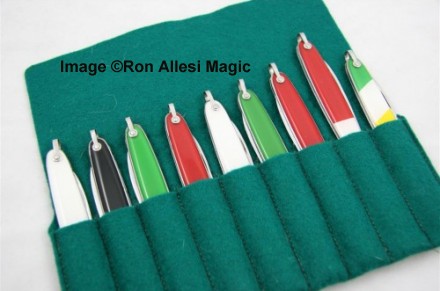
Routines: I do not
have any information on the routine that would have come
with this set. |
Juan
Tamariz' Color Changing Knives.
Stevens
Magic Emporium had these in their catalog for some
time, but they don't seem to be available any
longer. They look very similar to the Jose de la Torre
knives below, with a dull finish, and include a ring on one
end as shown in the photo. These knives are featured in
Stevens' Greater Magic Library Volume 41 featuring Juan
Tamariz (thus the name).
They also appear to be the knives described in Jose De La
Torre's translation of Ascanio's World of Knives. Jose De La
Torre recommends the key-ring ring to aid in identifying the
knife in your pocket. Also, though hard to see in this
photo, the knives only have two rivets, making them more
symmetrical when flipped.
I have never handled these knives, so I cannot comment on
their use, but they look to be the right size and shape and
are probably worth getting! A few years ago, you could get a
set of these for about $65 for a three knife set.
|
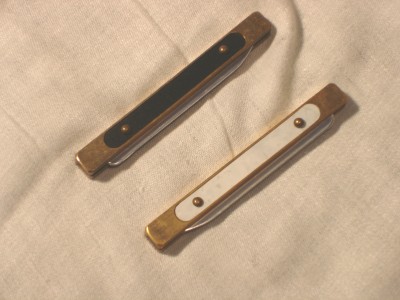
Photo courtesy Ray Szwec
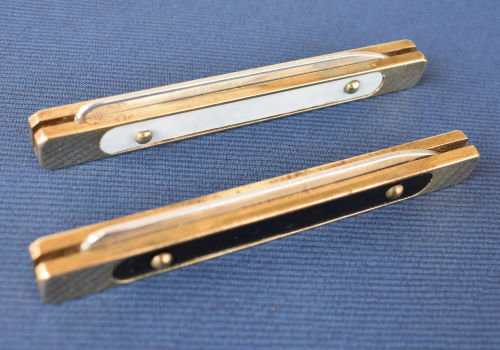
Image from Magicref
|
Tannen's
Magic - Tony Spina:
Definitive Color Changing Knives.
These "knives" are unique in that there are no real blades,
which makes them safe for handling. They appear to be real
pocket knives, but there is no real blade to open, making
the safe for handling by your spectators.
They were designed with Formica handles inlaid to prevent
any possibility of flashing.
The original set included the Merrill Knife Book. The
two knife set with Merrill Knife book listed for $45 in the
1990's.
Even though they don't have working blades, I still don't
think I'd risk taking them on my airline carry-on luggage! I
can imagine trying to explain them to security.
A later ad in Magic by Tannen's states, "Yes, as promised,
we now have completed The Visible Color Changing Knife",
which could be added to your set along with a felt carrying
case. The Visible Color Changing knife was listed for about
$25.
Advertised in Genii, Feb 1995
Also in Magic, April 1995
Reviewed in Genii May 1995
|
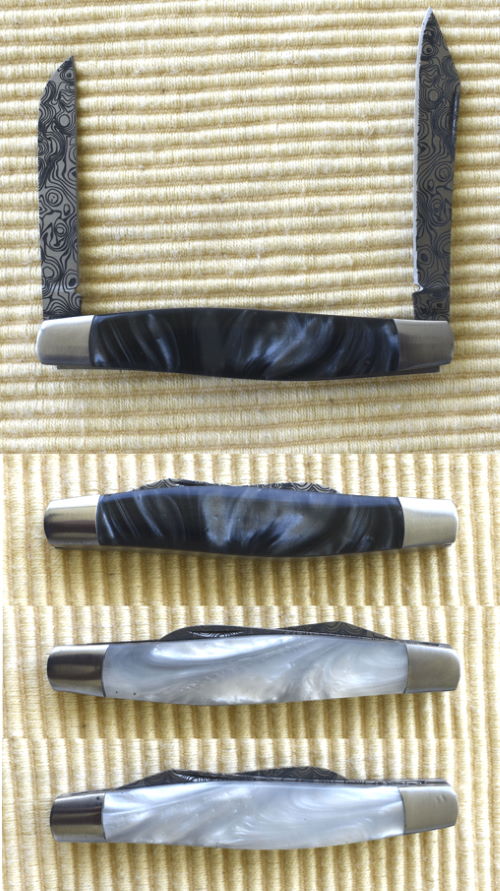
|
TCC Presents:
Artisan Color Changing Knives
Set of three black and white knives, and leather storage
bag. Shell-white and Ink-black jade handles. Two bladed
knives feature bolsters at both ends and beautiful Damascus
patterned blades.
The knives are 2 & 15/16 inches (74.5mm) long in closed
position.
While almost the same length as the Regal knives, these are
more narrow and lighter. I really like these knives, but I
have smaller hands so those with large hands might prefer
something a bit more hefty.
Fit and finish is very nice, with no gaps between the
handles and bolsters.
Blades are not stamped with country of origin.
Comes with online video instructions. $120. |
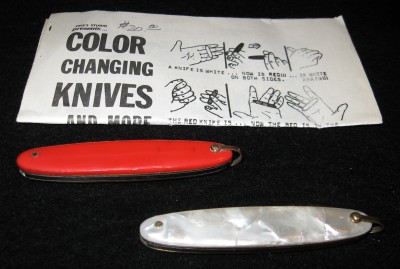
Color Changing Knives
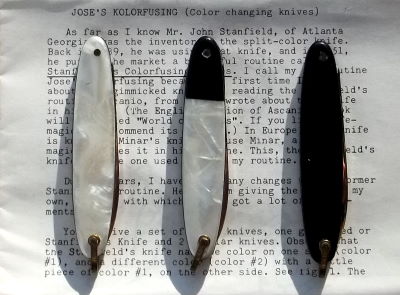
Kolorfusing Knife Set
|
Jose
De La Torre Color Changing Knives
I purchased this two knife set from e-Bay. According to the
instructions, it was supposed to come with three knives (the
full red knife was missing from the set). The instructions
look original, and are © Jose M. De La Torre 1976. The
red knife has some blemishes, and the white knife is
slightly cracked at the edges, but overall they are in good
shape.
The imprint on the blades are a bit difficult to read, but
it looks like it says: "IPAYA INOXIDABLE" (the Ipaya is
clear, the 2nd word is a bit pressed together). "Inoxidable"
is a Spanish word for "Stainless Steel", Ipaya seems to be a
place in Tanzania or perhaps Nigeria, Africa. So, perhaps
these are African made knives (?).
The knives in the bottom photo appear to be identical to the
Juan Tamariz' knives above, at least in design. I'm sure
there have been several manufacturers of these style of
knives through the years. The blades open cleanly, and
overall the quality is very nice.
In handling, I still find the Mogar superior, but these
knives are certainly fine and I know they are preferred by
some. They seem to be exactly as defined in Jose's
translation of Ascanio's
World of Knives.
The Kolorfusing set includes the visible-color change knife.
It retailed for around $35 in the mid 1990's.
These knives had a long existence, as I've seen ads for them
as early as 1975, and later in 1994.
Reviewed in Genii, April 1975.
Reviewed in The New Tops, October 1994.
Jose's Studio, Bellevill, NJ.
|

|
Jose De La Torre: Smash
Climax Knives
I got these miniature knives along with my purchase of the
Pakistani-made Merrill-type knives, so I'm not positive
these are Jose de la Torre's but they seem to match the
description.
They are excellent for use as a "smash climax" ending to a
knife routine, where a flood of tiny knives falls from the
performer's hand.
These knives are well made for such a small size. The
knives do all open, and you can see how small they are in
comparison to the dime.
As far as I know, these knives are no longer available, but
Joe Mogar makes a set of tiny knives that could be used.
|
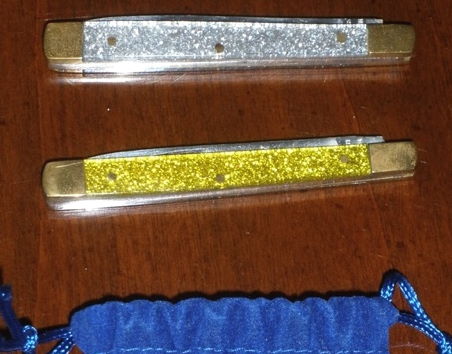
Image courtesy eBay seller jwells85018yi1
|
Twin Cities Magic
Ultra Color Changing Knives
These knives were made in the same Pakistan factory as the
2nd generation Merrill knives, so share the same, good
handling features. The sparkle handles helps them stand out.
|
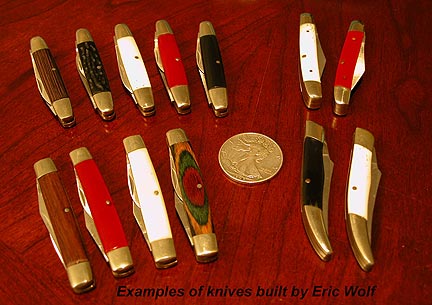 |
Eric
Wolf's Color Changing Knives:
Eric Wolf produced various sets of color changing knives
back in the late 1990's. A pair of knives cost around $90 a
pair or so (if memory serves me correctly) and were well
received. The handle covers are made of various materials,
including walnut and maple wood. I had seen a pair at Denny
& Lee's magic shop, but alas neglected to ask if I could
handle them so I can't make any comments on performance!
The design at the top left in the photo is similar to the
Bay Area Magic Ultra
Knives, but they did not include the rive in their
handle design.
I had confused these knives in a previous edition of this
page and I apologize! |

Image courtesy Michael Close

Image of original prototypes from Tabman
Routine: The routine was an integral part of this
set. It was a complete 36 page book by Scott York: Original Handling and Presentation of The Color
Changing Pocketknives. It is a very good routine,
and a full description can be found in the Books section. |
Scotty York Knives:
I don't own a set of these knives, and sadly they are no
longer available. According to a post on the Genii forum by
Brad Jeffers, there were 8 different color combinations
made. "The first ones produced were a set of 4 knives, 1
solid white, 1 solid black, 1 black/white and 1
black/yellow. In later sets the black/yellow was replaced
with a black/red, the reason being that some people were
concerned with there not being enough contrast between the
white and yellow colors (although Scotty still prefers the
original yellow). There was also another set of 3 knives
made - the "colorfusing" set. This consists of a solid red
knife, a red/white, and red/white knife with one side two
thirds white and one third red, for a "visible" color
change." The set pictured at the left appears to be a mix of
these!
There are many good features about these knives: 1) they
look just like a knife you would carry, including color
choices; 2) bolsters on both ends help prevent flashing; 3)
size and shape enhance the moves; 4) use of a stag handle
aids locating the knife in your pocket.
Potential negatives include: 1) Shield on one side takes
attention away from color change, and some people actually
think this is a button that causes the knives to change
color (!); 2) On the samples I saw, there were noticeable
gaps between the covers and the bolsters, though the knives
opened and closed well. I don't know who made the knives or
if they are stamped with the name of the manufacturer (I
forgot to look at the base of the blade).
The set of four knives originally sold for $48 in the mid
1990's.
The photo here was contributed by Michael Close. The
pictured set sold on e-Bay for over $150. A similar 4
knife set sold in April 2005 for $135.
Reviewed in Stan Allen's Magic magazine, January
1994.
Scotty York, FYEO Productions, Alexandria, VA.
|
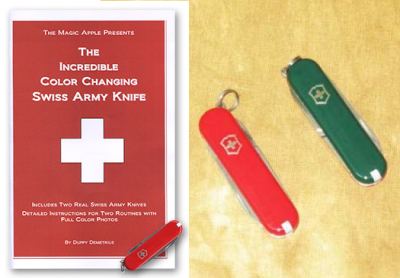
Image from The Magic Apple
|
The Magic Apple:
The Incredible Color Changing Swiss Army Knife (Duffy
Demetrus).
Includes two real Swiss Army Knives (one regular, one
gaffed), detailed 3 page instructions for two routines with
full color photos. Cost was just at $100. |
|
This is a side by side comparison of
several of the knives. From left to right: Ronjo; Powell
Swiss Army Knife; Fantastic Magic Co. (new style), Merrill
(Japan); Jose De La Torre; Fantastic Magic Co. (Older
style); Ganson (India); Enardoe Style
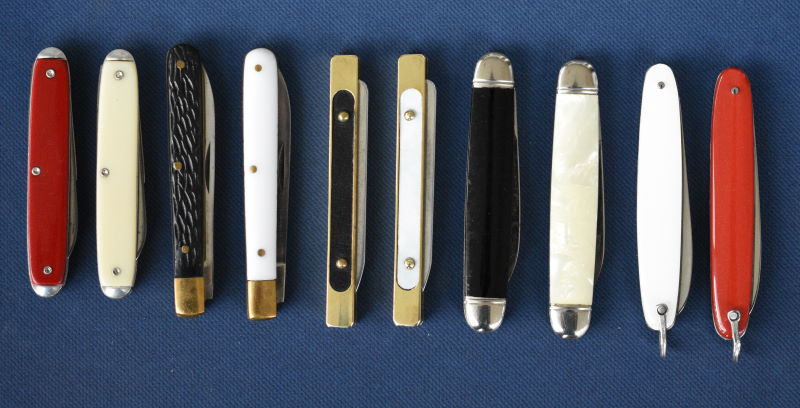
This is another side by side comparison. From left to
right: Fantastic Magic Co. (old style); Mogar Knives; Tony
Spina Definitive Knijves; Enardo Knives; and Casavalle
Knives.
|






















